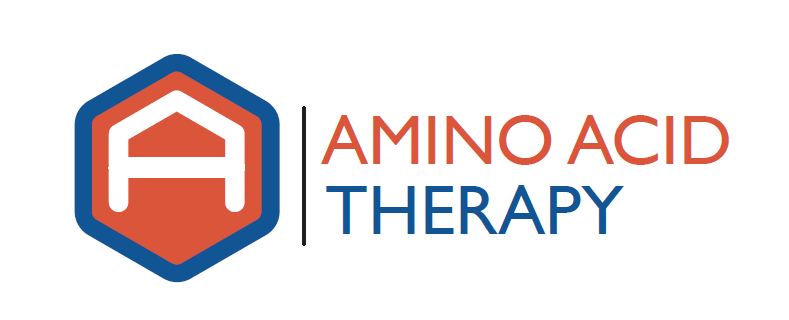Each neurotransmitter is made from a specific amino acid through a series of steps that require specific nutrients (called cofactors). Taking these amino acids and cofactors is the only way to improve neurotransmitter levels and function in the brain because the neurotransmitters themselves cannot cross the blood-brain barrier.
Picture from Marty Hinz, MD: www.neuroassist.com
Neurotransmitter systems
Neurotransmitters are either inhibitory or excitatory in their effect on the nervous system. Because of this, they work in opposing pairs to make sure the body’s systems stay in balance. There are several of these systems set up in the body; the two most studied are the serotonin-catecholamine system and the GABA-glutamate system.
Serotonin is a key inhibitory neurotransmitter in the body; dopamine, norepinephrine and epinephrine, collective known as the ‘catecholamines’ are key excitatory neurotransmitters. The serotonin-catecholamine system has a role, either directly or indirectly, in controlling most of the other systems and functions in the body. For example, cortisol synthesis, hormone synthesis and the sympathetic nervous system are all controlled by norepinephrine; mood, body temperature and sleep are regulated by serotonin and norepinephrine; and focus, concentration, memory and fine-motor skills are controlled by dopamine.
Anxiety control – using neurotransmitter system priority to find a lasting solution
In addition, other neurotransmitter systems are partially controlled by the serotonin-catecholamine systems. For example, the GABA-glutamate neurotransmitter system is associated with control of anxiety and panic attacks. Because of this, most of the medications prescribed to treat anxiety and/or panic attacks work on GABA receptors; these drugs include lorazepam (Ativan), clonazepam (Klonopin), diazepam (Valium) and alprazolam (Xanax). These drugs may help reduce the feeling of anxiety in the short-term, but do not provide lasting relief and can lead to dependence and withdrawal reactions.
Interestingly, a longer-term approach may be found if we look at the priority of neurotransmitter systems. It appears that the GABA-glutamate system is at least partially controlled by the serotonin-catecholamine system. This was discovered through clinical evaluation; when the serotonin and catecholamine neurotransmitter levels are brought to proper levels (as confirmed through laboratory testing), anxiety and panic attacks usually resolve. This indicates control of the GABA-glutamate system by the serotonin-catecholamine system even though at this time we have been unable to identify a chemical pathway for such in the literature.
Based on our clinical observation (and the observations of others, including Marty Hinz, MD), it is our assertion, that it is possible to restore proper balance to GABA-glutamate system by first addressing imbalances in the serotonin-catecholamine system. This means that the best amino acids to control symptoms of anxiety are not GABA or glutamate as they work with the secondary system. The best amino acids to use would be 5-HTP (or L-tryptophan) and L-tyrosine so that we influence the primary serotonin-catecholamine system. Doing so restores proper functioning by getting to the root cause and provides a long-term solution. In the rare case that optimal functioning of the serotonin-catecholamine system is achieved and symptoms are still present, then one can address any remaining imbalances in the GABA-glutamate system much more easily and directly.
Hormone imbalances – Addressing the cause to find the proper solution
Interestingly we have found the same to hold true with many hormone imbalances. We have noted previously that neurotransmitters are chemical messengers in the body that control bodily functions. Hormones represent another class of chemical messengers. In regards to hormone imbalances, we have found that if we balance the serotonin-catecholamine system as a first course of action (i.e., serotonin and dopamine), many symptoms associated with hormone imbalance (e.g., hot flashes, mood swings, irregular menses, etc.) often resolve or are reduced. Therefore, it is our assertion that in most cases, the serotonin-catecholamine system needs to be balanced first (or at the very least in concert with hormones) in order to properly manage symptoms of hormone imbalance. Once optimal neurotransmitter function is achieved, any remaining hormone imbalances can then be clearly defined and addressed.
In either case, the important thing is to keep looking upstream to find the root imbalance so we can achieve a lasting solution. Only by determining and addressing the root cause can we eliminate symptoms for the long term. In many cases, this means getting the serotonin-catecholamine system to function properly first; the best amino acids to do this are 5-HTP (or L-tryptophan) and L-tyrosine. Once the serotonin-catecholamine system is in balance any remaining imbalances can then be easily identified and addressed.



This is wonderful information. Thankyou kindly.
Thanks for the compliment Talia – I hope you find the information useful –
Sincerely,
Dr Chad